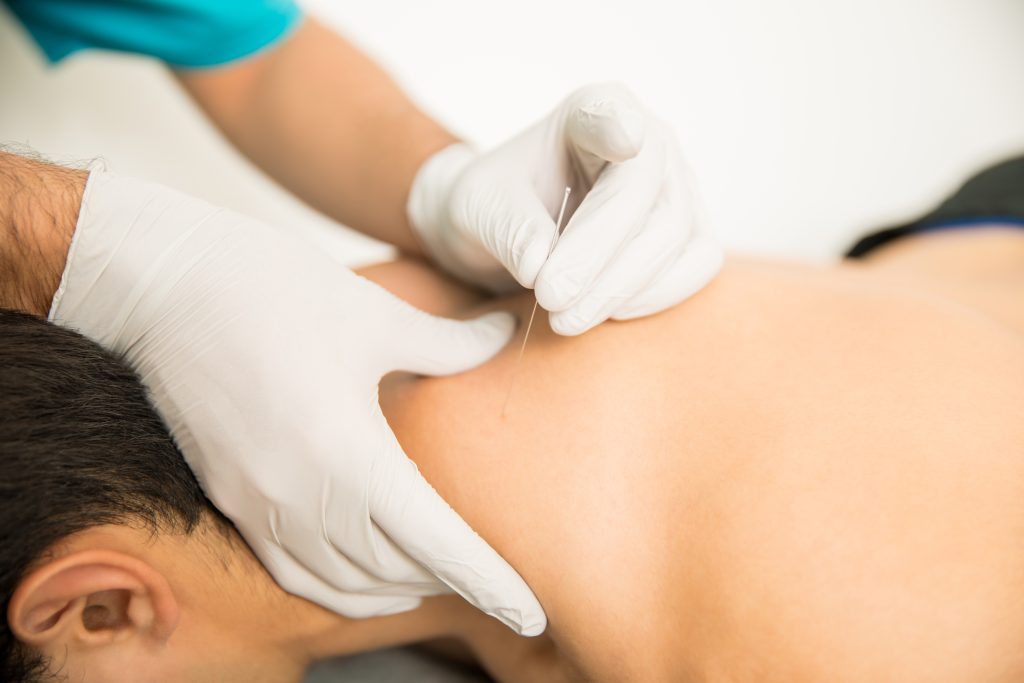
Pain Management involves relief of pains from sport injuries, chronic pains in back, neck and shoulders, and so on. Acupuncture for pain management is a complementary therapy that is being increasingly used in the day-to-day management of pain.
Acupuncture can help with drug-free pain relief and management. According to the National Institute of Health (NIH, a part of the U.S. Department of Health and Human Services, also the nation’s medical research agency), a number of studies suggest that acupuncture works particularly well on chronic pain such as back and neck pain; osteoarthritis/knee pain; and headache. It often reduces the incidence and severity of tension headaches and may prevent migraines. “Therefore,” the NIH concludes, “acupuncture appears to be a reasonable option for people with chronic pain to consider”. Both the National Institutes of Health and the World Health Organization has acknowledged acupuncture as an effective treatment modality for conditions involving pain and nausea.
A review article that appeared in Practical Pain Management found that pain relief with acupuncture comes from inactivating the source of pain by modulating endorphin levels. These authors also reported on the benefits of acupuncture for temporomadibular joint disorder (TMD).
The following information is extracted from the information sheet by the Research Committee of the Australia Acupuncture and Chinese Medicine Association (AACMA):

In 2009, the National Health Service of the United Kingdom wrote in their low back pain clinical management guideline that for early management of persistent non-specific low back pain, “an exercise programme, a course of manual therapy, or a course of acupuncture” should be recommended at the early stage. In addition, trials on neck pain, headache, and osteoarthritis in the knee have all shown that acupuncture not only reduces pain but also improves patients’ physical function in the long term.
The 2010 edition (3rd ed.) of “Acute Pain Management: Scientific Evidence” by the Australian and New Zealand College of Anaesthetists and Faculty of Pain Medicine states that there is level one evidence (the highest level) that acupuncture is effective in reducing post-operative pain and opioid-related adverse effects.”
Acupuncture is an integral part of Traditional Chines Medicine (TCM). According to TCM, pain is caused by disturbed or imbalanced circulation of two of these vital materials in particular. These are the Qi (pronounced as Chee) and blood. The Qi and blood flow in channels networking the body. As long as qi (vital energy) and blood flow freely and smoothly without hindrance or obstruction, there is no pain in the body. However, if, due to any reason, the flow of qi and blood is hindered, blocked, obstructed, or does not flow freely, then there will be pain.
Acupuncture improves the body’s functions and promotes the natural self-healing process by stimulating specific anatomic sites, commonly referred to as acupuncture points, or acupoints. It involves the insertion of fine, sterile needles into the skin at specific acupoints to release blocked qi in the body. Modern research has demonstrated acupuncture’s effects on the nervous system, endocrine and immune systems, cardiovascular system, and digestive system. By stimulating the body’s various systems, acupuncture can help to resolve pain, and improve sleep, digestive function, and sense of well-being.
When use acupuncture to manage pains, according to patient case, we also utilise traditional Chinese medicine external treatment in conjunction with special formulas derived from our clinical experience exclusive to our clinic.
For more information regarding acupuncture for pain management, please call your closest location (Perth clinic: 57/76 Newcastle Street (08) 9228 8828, Subiaco Clinic: 6/1 Sheen Street (08) 9380 4171). Alternatively, you can send us your queries through our online contact page.
Pain Management involves relief of pains from sport injuries, chronic pains in back, neck and shoulders, and so on. Acupuncture for pain management is a complementary therapy that is being increasingly used in the day-to-day management of pain.
Acupuncture can help with drug-free pain relief and management. According to the National Institute of Health (NIH, a part of the U.S. Department of Health and Human Services, also the nation’s medical research agency), a number of studies suggest that acupuncture works particularly well on chronic pain such as back and neck pain; osteoarthritis/knee pain; and headache. It often reduces the incidence and severity of tension headaches and may prevent migraines. “Therefore,” the NIH concludes, “acupuncture appears to be a reasonable option for people with chronic pain to consider”. Both the National Institutes of Health and the World Health Organization has acknowledged acupuncture as an effective treatment modality for conditions involving pain and nausea.
A review article that appeared in Practical Pain Management found that pain relief with acupuncture comes from inactivating the source of pain by modulating endorphin levels. These authors also reported on the benefits of acupuncture for temporomadibular joint disorder (TMD).
The following information is extracted from the information sheet by the Research Committee of the Australia Acupuncture and Chinese Medicine Association (AACMA):

In 2009, the National Health Service of the United Kingdom wrote in their low back pain clinical management guideline that for early management of persistent non-specific low back pain, “an exercise programme, a course of manual therapy, or a course of acupuncture” should be recommended at the early stage. In addition, trials on neck pain, headache, and osteoarthritis in the knee have all shown that acupuncture not only reduces pain but also improves patients’ physical function in the long term.
The 2010 edition (3rd ed.) of “Acute Pain Management: Scientific Evidence” by the Australian and New Zealand College of Anaesthetists and Faculty of Pain Medicine states that there is level one evidence (the highest level) that acupuncture is effective in reducing post-operative pain and opioid-related adverse effects.”
Acupuncture is an integral part of Traditional Chines Medicine (TCM). According to TCM, pain is caused by disturbed or imbalanced circulation of two of these vital materials in particular. These are the Qi (pronounced as Chee) and blood. The Qi and blood flow in channels networking the body. As long as qi (vital energy) and blood flow freely and smoothly without hindrance or obstruction, there is no pain in the body. However, if, due to any reason, the flow of qi and blood is hindered, blocked, obstructed, or does not flow freely, then there will be pain.
Acupuncture improves the body’s functions and promotes the natural self-healing process by stimulating specific anatomic sites, commonly referred to as acupuncture points, or acupoints. It involves the insertion of fine, sterile needles into the skin at specific acupoints to release blocked qi in the body. Modern research has demonstrated acupuncture’s effects on the nervous system, endocrine and immune systems, cardiovascular system, and digestive system. By stimulating the body’s various systems, acupuncture can help to resolve pain, and improve sleep, digestive function, and sense of well-being.
When use acupuncture to manage pains, according to patient case, we also utilise traditional Chinese medicine external treatment in conjunction with special formulas derived from our clinical experience exclusive to our clinic.
For more information regarding acupuncture for pain management, please call your closest location (Perth clinic: 57/76 Newcastle Street (08) 9228 8828, Subiaco Clinic: 6/1 Sheen Street (08) 9380 4171). Alternatively, you can send us your queries through our online contact page.

© Copyright 2022. Baolin Acupuncture & Chinese Medicine Centre. All Rights Reserved.